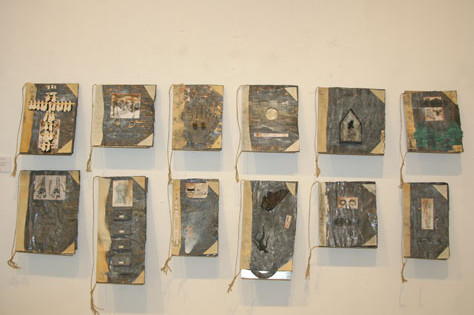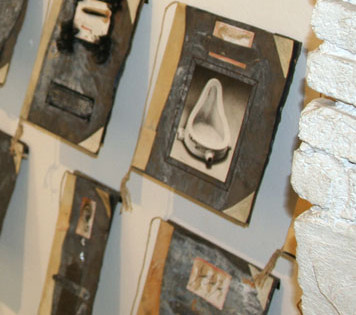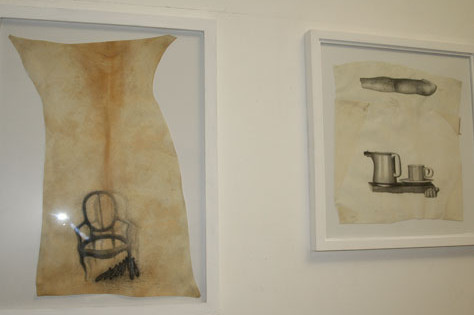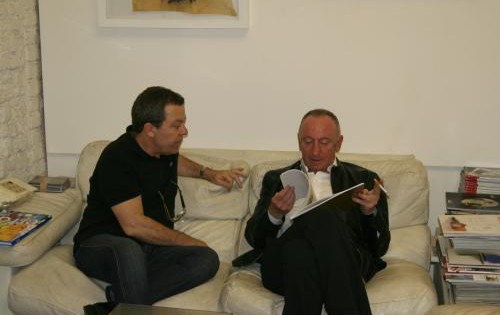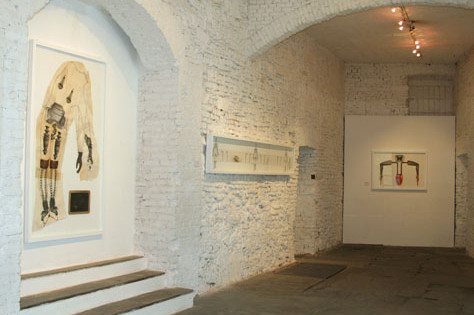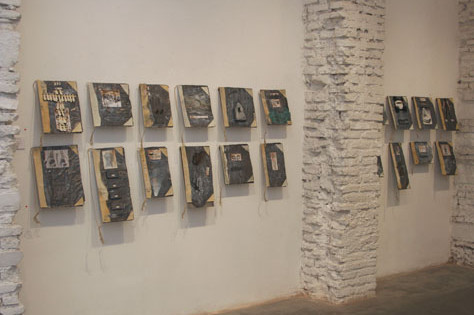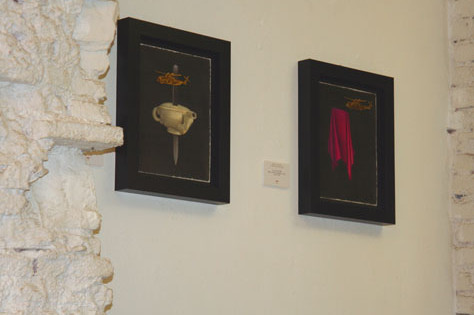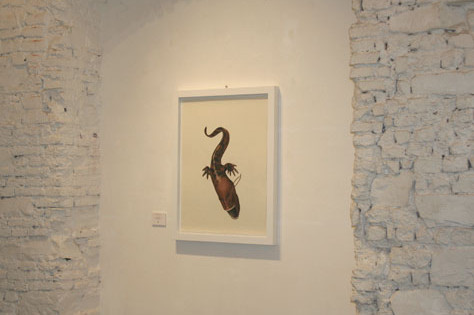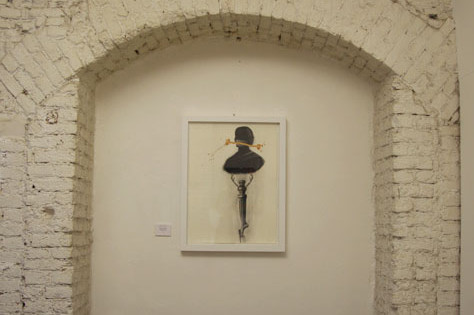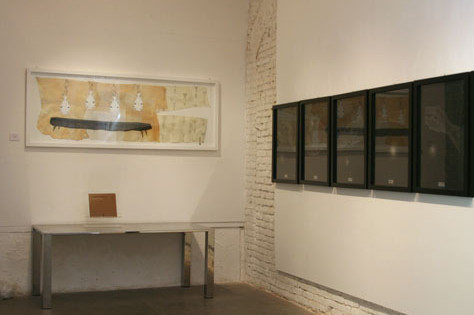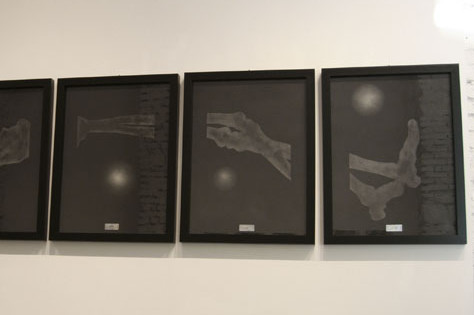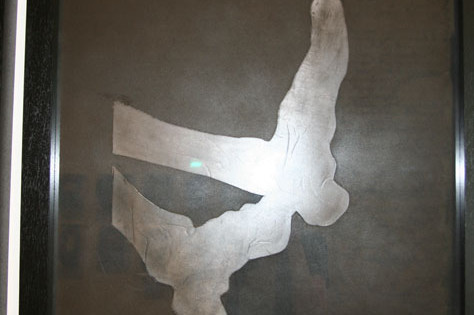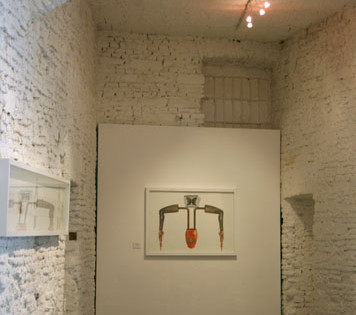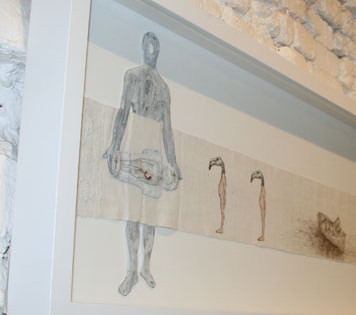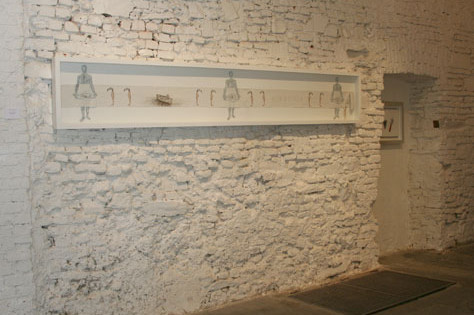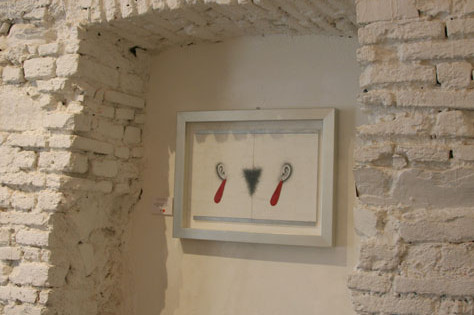JOSE’ D’APICE Il libro che mi manca
A disturbing and problematic explorer of the imagination and subconscious, José D’Apice has, in time, generated a fantastic world loaded with cryptic implications and a vast and intricate collection of literary, scientific and anthropological references with the most diverse origins.
And he has done so by putting into practice compositional modalities based on operations that continue to catch us off balance, which consist of the combination, fusion and metamorphic transformation of the iconic elements (but also of the concrete materials) he uses to produce his works. The unusual and most surprising feature of these is the often hyper-real effect that derives from a figurative elaboration of maniacal precision. There is, however, no virtuosity in this. His intention is to create, above all by means of mixed technique drawing and collage, a dimension of high-strung and hallucinated suggestiveness that is radically different from normal logic. There is no doubt that surrealist culture (the taste for “l’humour noir”, for instance) has been fundamental in the making and development of D’Apice’s work, yet other than the basic linguistic forms there are no direct influences from famous artists.
D’Apice’s visions and obsessions are expressions of a personal and liberal narration by images which moves in the opposite direction from the reality of everyday experience in order to sink into the bowels and subterranean levels of the obscure meanings of life and death. It is a narration which does not seek reassuring answers or solutions (which do not exist) and which does not eliminate contradictions, ambiguities and enigmas or individual and collective existential nightmares, but deals with all this directly by means of the only relatively redeeming possibility he has, that of projecting the interior outwards into the circumscribed and separate spaces of the art works. And, obviously, each individual work can only be a partial element of this process, which materialises in the show of figures and objects depicted and assembled with deliberate distancing theatricality.
It is a sophisticated puppet theatre of the absurd made up of parts of mannequins, human silhouettes pieced together like improbable puzzles, skeletons with grinning skulls, strange beast-objects. And then there are also the known and unknown characters, to whom he dedicates a long series of “books” sui generis, made of lead and other materials. The artist introduces himself in a “Self-portrait after”, which is the quintessence of grotesque self-irony built upon a radical tipping of balances. Above we see the head and torso of a navigator (Columbus, Vespucci?), whose face is filled with an enormous set of cannibal-like teeth clenching a bone. This figure continues below with two small skeleton arms and a table leg, which turns into the foot of a dancer, which supports (so to speak) the whole construction that rests on a tiny chair. The only thing that might be inferred is a reference to the cruelty of the conquest of America on the part of the Europeans.
“Visione dall’alto” and “Illuminata” are two more examples of José’s skill as a draughtsman, and also his incredible surreal-baroque imagination.
“Illuminata” is a diptych with a perfectly symmetrical structure that shows us two mannequin legs which are bent and open. The feet encased in ballerina pumps are resting on two small silhouettes of dancers while, in the centre, there is a vase below, into which the tubes that are extensions of the legs enter, and a butterfly above, which is embroidered on a fragment of material. It is not difficult to give it a sexual erotic interpretation.
“Visione dall’alto” is more complex and intriguing. It is a large work on parchment where we see the linear silhouette of a headless figure standing with dangling arms. This spectral personality is partially filled with various objects that form anew some parts of the body in an absurd manner. But the most disturbing aspect is seen below, where the feet, transformed into monkey-like appendages, are resting on a skull-cap. Alongside there is an actual small blackboard with a drawing of a brain. What is man’s destiny? Evolution or regression, civilisation or savagery, reason or madness? This problematic vision of humanity may be linked with a rather bizarre “small imperfect atlas of the world”, a long polyptych produced by a series of large drawings, each of which is supposed to represent a continent, at least according to the banderols below. But these “continents” are actually drawn like pieces of a human skeleton: the skull, the ribcage, the pelvis, the upper and lower part of the legs and the feet. On the dark background a sphere alluding to our planet or a different one can be seen floating in various positions. The work has a particularly suggestive intensity.
An important part of the exhibition is made up of a sequence of around twenty small assemblages on a lead base, which look like books where, by means of small traces of objects, elements which appear to be relics, and images, the lives of various personalities are “narrated” in an allusive way, through metaphors, symbols and other, rather anodyne, signs. There are two homages to famous artists such as Marcel Duchamp and Lucio Fontana, but the lives of many unknown and mysterious people indicated only by their initials are much more interesting and enigmatic. It is a list that includes the taxidermist, the eunuch, the illusionist, the astronaut, the dowser, the priest, the mystic, the medium, the tightrope walker, the grave-digger, the florist, the midwife, the prostitute and others. All these trades are characterised by a melancholy and even graveyard atmosphere, by a poignant sense of past time. In a certain sense, even though in a very different form , they remind us of the short lives of the dead who lie in Spoon River cemetery.
The exhibition is entitled “The book I’m missing”. Obviously this is the one which hasn’t been written yet and which will never be finished.
And perhaps it is the book of “The life of the artist J.D.”
_____________________________________________________________________________
Jose’ d’apice - Il libro che mi manca
Testo di Francesco Poli
Inquietante e problematico esploratore dell’immaginario e dell’incosciente, josè d’apice ha dato vita nel tempo a un mondo fantastico carico di implicazioni criptiche e di vasti e articolati riferimenti letterari, scientifici e antropologici delle più diverse provenienze.
E lo ha fatto mettendo in atto modalità compositive basate su operazioni sempre spiazzanti di combinazione, fusione e trasformazione metamorfica degli elementi iconici (ma anche dei materiali concreti) utilizzati per la realizzazione dei lavori.
La caratteristica peculiare e più sorprendente delle sue opere è l’effetto spesso iperreale che deriva da una elaborazione figurativa di maniacale precisione. Non c’è pero’ nulla di virtuosistico in questo: l’intenzione è quella di creare, soprattutto attraverso il disegno a tecnica mista e il collage, una dimensione di tesa e allucinata suggestione radicalmente altra rispetto alla logica normale.
Non c’è dubbio che la cultura surrealista (per esempio il gusto per l’”humour noir”) sia stata fondamentale nella formazione e nello sviluppo della ricerca di d’apice, ma al di là delle forme linguistiche di fondo non ci sono influenze dirette degli artisti più noti.
Le visioni e le ossessioni di d’apice sono espressioni di una personale e libera narrazione per immagini che va nella direzione opposta alla realtà dell’esperienza quotidiana per sprofondare nelle viscere e nei sotterranei dei sensi oscuri della vita e della morte.
Una narrazione che non cerca risposte o soluzioni rassicuranti (che non esistono) e che non rimuove le contraddizioni, le ambiguità e gli enigmi e anche gli incubi esistenziali individuali e collettivi, ma che affronta tutto questo direttamente attraverso l’unica possibilità relativamente liberatoria, quella della proiezione dall’interno verso l’esterno negli spazi circoscritti e separati delle opere artistiche.
E ovviamente ogni singola opera non puo’ che essere un elemento parziale di questo processo che prende forma attraverso la messa in scena di figure e oggetti configurati e aggregati con meditata tetralità straniante.
Si tratta di un raffinato teatrino dell’assurdo fatto di pezzi di manichini,
Sagome umane ricostruite come improbabili puzzle,
Scheletri ossa e teste ghignanti, strane bestie-oggetti. E poi
Ci sono anche i personaggi noti e ignoti a cui è dedicata
Una lunga serie di “libri” sui generis fatti di piombo e altro.
L’artista presenta se stesso in un “autoritratto dopo” che è
La quintessenza dell’autoironia grottesca costruita sul
Rovesciamento radicale degli equilibri. In alto vediamo la testa
E il busto di un navigatore (colombo, vespucci?) Ma con il volto
Occupato da una enorme chiostra di denti cannibaleschi che
Stringono un osso. Questa figura prosegue in basso con due piccole
Braccia scheletriche e una gamba di un tavolino, che si trasforma
In un piede da danzatore che regge (per così dire) tutta la costruzione,
Posato su una piccolissima sedia. L’unica cosa che si può arguire è
Che ci sia un riferimento alla crudeltà della conquista dell’america
Da parte degli europei.
“ visione dall’alto” e “illuminata” sono due altri esempi della perizia come
Disegnatore di josé, e anche della sua incredibile fantasia
Surreale-barocca.
“illuminata” è un dittico di impianto perfettamente
Simmetrico che ci mostra due gambe di manichino piegate e aperte.
I piedi con scarpette da ballerina poggiano su due piccole silhoutette
Di danzatrici, mentre in centro vediamo in basso un vaso in
Cui entrano i tubi prolungamenti delle gambe, e in alto una farfalla
Ricamata su un frammento di tessuto. Qui l’interpretazione in chiave
Erotica sessuale è abbastanza agevole.
Più complesso e intrigante è “visione dall’alto”, un grande lavoro su
Pergamena dove vediamo la sagoma lineare di una figura in piedi
Senza testa e con le braccia penzoloni. Questo personaggio
Fantasmatico è parzialmente riempito di oggetti vari che ricostruiscono
In modo assurdo alcune parti del corpo. Ma l’aspetto più inquietante
Lo vediamo in basso dove i piedi trasformati in appendici scimmiesche
Sono posati su una calotta cranica. A fianco c’è una vera piccola
Lavagnetta dove è disegnato un cervello. Qual’è il destino dell’uomo?
Evoluzione o regressione, civiltà o imbarbarimento, razionalità o follia?
A questa problematica visione dell’umanità si può collegare anche
Un assai bizzarro “piccolo atlante imperfetto del mondo”, un lungo polittico
Formato da una serie di grandi disegni, ciascuno dei quali dovrebbe rappresentare
Un continente, almeno se si leggono i cartigli in basso. Ma questi
“continenti” in effetti sono delineati come dei pezzi del corpo
Umano ischeletrito: il cranio, la gabbia toracica, il bacino, la parte
Superiore delle gambe e quella inferiore, e i piedi. Sullo
Sfondo scuro si vede fluttuare in posizioni variate una sfera che allude
Al nostro o a un altro pianeta. L’opera ha una sua particolare intensità
Suggestiva.
Una parte importante della mostra è costituita dalla sequenza di una
Ventina di piccoli assemblage su base in piombo che hanno l’aspetto di
Libri, dove attraverso piccole tracce oggettuali, elementi che sembrano
Reliquie e immagini sono “narrate” in modo allusivo, per metafore, simboli e
Altri segni piuttosto anodini le vite di vari personaggi. Ci sono due
Omaggi a famosi artisti come marcel duchamp e lucio fontana, ma sono
Molto più interessanti ed enigmatiche le vite di tanti ignoti e misteriosi tipi
Indicati solo con le iniziali. È un elenco che comprende l’imbalsamatore,
L’eunuco, l’illusionista, l’astronauta, il rabdomante, il pastore, il mistico,
Il medium, il funambolo, il becchino, la fioraia, la lettrice, la
Prostituta e altri. Tutti questi lavori sono caratterizzati da un’atmosfera
Melanconica e anche mortuaria, da uno struggente senso del tempo passato.
Per certi versi, anche se in forma diversissima, fanno venire in mente
Le brevi vite dei morti del cimitero di spoon river.
La mostra si intitola “il libro che mi manca”, che ovviamente è quello
Che non è stato ancora fatto e che non si potrà mai finire.
E forse si tratta del libro “la vita dell’artista j.d.”
And he has done so by putting into practice compositional modalities based on operations that continue to catch us off balance, which consist of the combination, fusion and metamorphic transformation of the iconic elements (but also of the concrete materials) he uses to produce his works. The unusual and most surprising feature of these is the often hyper-real effect that derives from a figurative elaboration of maniacal precision. There is, however, no virtuosity in this. His intention is to create, above all by means of mixed technique drawing and collage, a dimension of high-strung and hallucinated suggestiveness that is radically different from normal logic. There is no doubt that surrealist culture (the taste for “l’humour noir”, for instance) has been fundamental in the making and development of D’Apice’s work, yet other than the basic linguistic forms there are no direct influences from famous artists.
D’Apice’s visions and obsessions are expressions of a personal and liberal narration by images which moves in the opposite direction from the reality of everyday experience in order to sink into the bowels and subterranean levels of the obscure meanings of life and death. It is a narration which does not seek reassuring answers or solutions (which do not exist) and which does not eliminate contradictions, ambiguities and enigmas or individual and collective existential nightmares, but deals with all this directly by means of the only relatively redeeming possibility he has, that of projecting the interior outwards into the circumscribed and separate spaces of the art works. And, obviously, each individual work can only be a partial element of this process, which materialises in the show of figures and objects depicted and assembled with deliberate distancing theatricality.
It is a sophisticated puppet theatre of the absurd made up of parts of mannequins, human silhouettes pieced together like improbable puzzles, skeletons with grinning skulls, strange beast-objects. And then there are also the known and unknown characters, to whom he dedicates a long series of “books” sui generis, made of lead and other materials. The artist introduces himself in a “Self-portrait after”, which is the quintessence of grotesque self-irony built upon a radical tipping of balances. Above we see the head and torso of a navigator (Columbus, Vespucci?), whose face is filled with an enormous set of cannibal-like teeth clenching a bone. This figure continues below with two small skeleton arms and a table leg, which turns into the foot of a dancer, which supports (so to speak) the whole construction that rests on a tiny chair. The only thing that might be inferred is a reference to the cruelty of the conquest of America on the part of the Europeans.
“Visione dall’alto” and “Illuminata” are two more examples of José’s skill as a draughtsman, and also his incredible surreal-baroque imagination.
“Illuminata” is a diptych with a perfectly symmetrical structure that shows us two mannequin legs which are bent and open. The feet encased in ballerina pumps are resting on two small silhouettes of dancers while, in the centre, there is a vase below, into which the tubes that are extensions of the legs enter, and a butterfly above, which is embroidered on a fragment of material. It is not difficult to give it a sexual erotic interpretation.
“Visione dall’alto” is more complex and intriguing. It is a large work on parchment where we see the linear silhouette of a headless figure standing with dangling arms. This spectral personality is partially filled with various objects that form anew some parts of the body in an absurd manner. But the most disturbing aspect is seen below, where the feet, transformed into monkey-like appendages, are resting on a skull-cap. Alongside there is an actual small blackboard with a drawing of a brain. What is man’s destiny? Evolution or regression, civilisation or savagery, reason or madness? This problematic vision of humanity may be linked with a rather bizarre “small imperfect atlas of the world”, a long polyptych produced by a series of large drawings, each of which is supposed to represent a continent, at least according to the banderols below. But these “continents” are actually drawn like pieces of a human skeleton: the skull, the ribcage, the pelvis, the upper and lower part of the legs and the feet. On the dark background a sphere alluding to our planet or a different one can be seen floating in various positions. The work has a particularly suggestive intensity.
An important part of the exhibition is made up of a sequence of around twenty small assemblages on a lead base, which look like books where, by means of small traces of objects, elements which appear to be relics, and images, the lives of various personalities are “narrated” in an allusive way, through metaphors, symbols and other, rather anodyne, signs. There are two homages to famous artists such as Marcel Duchamp and Lucio Fontana, but the lives of many unknown and mysterious people indicated only by their initials are much more interesting and enigmatic. It is a list that includes the taxidermist, the eunuch, the illusionist, the astronaut, the dowser, the priest, the mystic, the medium, the tightrope walker, the grave-digger, the florist, the midwife, the prostitute and others. All these trades are characterised by a melancholy and even graveyard atmosphere, by a poignant sense of past time. In a certain sense, even though in a very different form , they remind us of the short lives of the dead who lie in Spoon River cemetery.
The exhibition is entitled “The book I’m missing”. Obviously this is the one which hasn’t been written yet and which will never be finished.
And perhaps it is the book of “The life of the artist J.D.”
_____________________________________________________________________________
Jose’ d’apice - Il libro che mi manca
Testo di Francesco Poli
Inquietante e problematico esploratore dell’immaginario e dell’incosciente, josè d’apice ha dato vita nel tempo a un mondo fantastico carico di implicazioni criptiche e di vasti e articolati riferimenti letterari, scientifici e antropologici delle più diverse provenienze.
E lo ha fatto mettendo in atto modalità compositive basate su operazioni sempre spiazzanti di combinazione, fusione e trasformazione metamorfica degli elementi iconici (ma anche dei materiali concreti) utilizzati per la realizzazione dei lavori.
La caratteristica peculiare e più sorprendente delle sue opere è l’effetto spesso iperreale che deriva da una elaborazione figurativa di maniacale precisione. Non c’è pero’ nulla di virtuosistico in questo: l’intenzione è quella di creare, soprattutto attraverso il disegno a tecnica mista e il collage, una dimensione di tesa e allucinata suggestione radicalmente altra rispetto alla logica normale.
Non c’è dubbio che la cultura surrealista (per esempio il gusto per l’”humour noir”) sia stata fondamentale nella formazione e nello sviluppo della ricerca di d’apice, ma al di là delle forme linguistiche di fondo non ci sono influenze dirette degli artisti più noti.
Le visioni e le ossessioni di d’apice sono espressioni di una personale e libera narrazione per immagini che va nella direzione opposta alla realtà dell’esperienza quotidiana per sprofondare nelle viscere e nei sotterranei dei sensi oscuri della vita e della morte.
Una narrazione che non cerca risposte o soluzioni rassicuranti (che non esistono) e che non rimuove le contraddizioni, le ambiguità e gli enigmi e anche gli incubi esistenziali individuali e collettivi, ma che affronta tutto questo direttamente attraverso l’unica possibilità relativamente liberatoria, quella della proiezione dall’interno verso l’esterno negli spazi circoscritti e separati delle opere artistiche.
E ovviamente ogni singola opera non puo’ che essere un elemento parziale di questo processo che prende forma attraverso la messa in scena di figure e oggetti configurati e aggregati con meditata tetralità straniante.
Si tratta di un raffinato teatrino dell’assurdo fatto di pezzi di manichini,
Sagome umane ricostruite come improbabili puzzle,
Scheletri ossa e teste ghignanti, strane bestie-oggetti. E poi
Ci sono anche i personaggi noti e ignoti a cui è dedicata
Una lunga serie di “libri” sui generis fatti di piombo e altro.
L’artista presenta se stesso in un “autoritratto dopo” che è
La quintessenza dell’autoironia grottesca costruita sul
Rovesciamento radicale degli equilibri. In alto vediamo la testa
E il busto di un navigatore (colombo, vespucci?) Ma con il volto
Occupato da una enorme chiostra di denti cannibaleschi che
Stringono un osso. Questa figura prosegue in basso con due piccole
Braccia scheletriche e una gamba di un tavolino, che si trasforma
In un piede da danzatore che regge (per così dire) tutta la costruzione,
Posato su una piccolissima sedia. L’unica cosa che si può arguire è
Che ci sia un riferimento alla crudeltà della conquista dell’america
Da parte degli europei.
“ visione dall’alto” e “illuminata” sono due altri esempi della perizia come
Disegnatore di josé, e anche della sua incredibile fantasia
Surreale-barocca.
“illuminata” è un dittico di impianto perfettamente
Simmetrico che ci mostra due gambe di manichino piegate e aperte.
I piedi con scarpette da ballerina poggiano su due piccole silhoutette
Di danzatrici, mentre in centro vediamo in basso un vaso in
Cui entrano i tubi prolungamenti delle gambe, e in alto una farfalla
Ricamata su un frammento di tessuto. Qui l’interpretazione in chiave
Erotica sessuale è abbastanza agevole.
Più complesso e intrigante è “visione dall’alto”, un grande lavoro su
Pergamena dove vediamo la sagoma lineare di una figura in piedi
Senza testa e con le braccia penzoloni. Questo personaggio
Fantasmatico è parzialmente riempito di oggetti vari che ricostruiscono
In modo assurdo alcune parti del corpo. Ma l’aspetto più inquietante
Lo vediamo in basso dove i piedi trasformati in appendici scimmiesche
Sono posati su una calotta cranica. A fianco c’è una vera piccola
Lavagnetta dove è disegnato un cervello. Qual’è il destino dell’uomo?
Evoluzione o regressione, civiltà o imbarbarimento, razionalità o follia?
A questa problematica visione dell’umanità si può collegare anche
Un assai bizzarro “piccolo atlante imperfetto del mondo”, un lungo polittico
Formato da una serie di grandi disegni, ciascuno dei quali dovrebbe rappresentare
Un continente, almeno se si leggono i cartigli in basso. Ma questi
“continenti” in effetti sono delineati come dei pezzi del corpo
Umano ischeletrito: il cranio, la gabbia toracica, il bacino, la parte
Superiore delle gambe e quella inferiore, e i piedi. Sullo
Sfondo scuro si vede fluttuare in posizioni variate una sfera che allude
Al nostro o a un altro pianeta. L’opera ha una sua particolare intensità
Suggestiva.
Una parte importante della mostra è costituita dalla sequenza di una
Ventina di piccoli assemblage su base in piombo che hanno l’aspetto di
Libri, dove attraverso piccole tracce oggettuali, elementi che sembrano
Reliquie e immagini sono “narrate” in modo allusivo, per metafore, simboli e
Altri segni piuttosto anodini le vite di vari personaggi. Ci sono due
Omaggi a famosi artisti come marcel duchamp e lucio fontana, ma sono
Molto più interessanti ed enigmatiche le vite di tanti ignoti e misteriosi tipi
Indicati solo con le iniziali. È un elenco che comprende l’imbalsamatore,
L’eunuco, l’illusionista, l’astronauta, il rabdomante, il pastore, il mistico,
Il medium, il funambolo, il becchino, la fioraia, la lettrice, la
Prostituta e altri. Tutti questi lavori sono caratterizzati da un’atmosfera
Melanconica e anche mortuaria, da uno struggente senso del tempo passato.
Per certi versi, anche se in forma diversissima, fanno venire in mente
Le brevi vite dei morti del cimitero di spoon river.
La mostra si intitola “il libro che mi manca”, che ovviamente è quello
Che non è stato ancora fatto e che non si potrà mai finire.
E forse si tratta del libro “la vita dell’artista j.d.”

